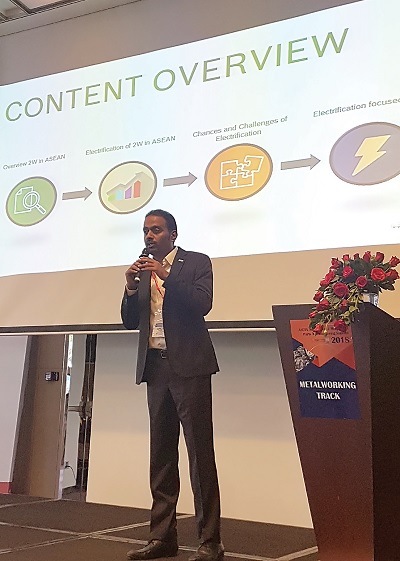
South East Asia is an important growth region for Bosch. By 2030, there will be at least five billion city dwellers globally and in the region alone, some 90 million people will move into cities – about 57 million of whom will belong to an aging population that continues to grow at an unprecedented pace, according to United Nations’ World Cities report.
The company believes that in order to sustain quality of life, alternative mobility models for cities are becoming increasingly vital, and governments, the industry, and the public can work together in making a difference in developing a future urban mobility landscape.
Mr. Guru Mallikarjuna, Managing Director of Bosch Vietnam Co. Ltd, is one of the key presenters of Ringier Trade Media’s ASEAN Automotive & Motorcycle Parts Manufacturing Summit (AAM) held in Ho Chi Minh, Vietnam.
“The increasing importance of South East Asia as an automotive hub, the rising middle class with its corresponding increase in purchasing power, urbanisation, and infrastructure projects all offer great opportunities,” he said.
Overview of two-wheeler in ASEAN
Two-wheel vehicles (scooters, motorcycles, and bicycles) are a very popular mode of transportation in ASEAN due to their fuel efficiency and ease of use in congested traffic. As a result, consumers are heavily adopting traditional two-wheel vehicles. Largely driven by costs, these vehicles provide a mode of transportation for individuals who may not be able to afford a car yet. In many places, scooters, motorcycles, and bicycles are designed to carry additional cargo and people and, therefore, are more accommodating to families.
“There is a high demand in the two-wheelers market due to rising environmental awareness, as well as the belief that electrification of two-wheelers is a significant growth field in the upcoming years,” said Guru.
Electrification of two-wheeler in ASEAN
Bosch has committed itself to electromobility in a systematic, integrated manner, allocating significant parts of its seven-billion-euro R&D budget on ensuring that powertrains are fit for the future; i.e., with environmental protection and resource conservation in mind. The International Energy Agency (IEA) estimates that urban areas account for 67% of energy-related global greenhouse gases; 28% of which is currently used for transport and without efforts to curb consumption and output, this will increase to roughly 70% in 2050.
With battery-powered electric two-wheelers becoming a major fixture in the vehicle ranges of leading manufacturers, electrification is seen to become a favoured alternative in further reducing CO2 emissions.
During his speech, Guru mentioned the governmental constitutions are pro electrification. He also explained Paris agreement ratified by every ASEAN member except Laos so far. And also there is a low entry barriers due to short supply chain.
Advantages of electrification
The importance for emission-free mobility especially in congested city traffic is recognised in ASEAN, where only electrified 2-Wheeler are permitted to enter downtown traffic area. The electrified two-wheeler offers a very big potential in this specific attempt for environmental friendly mobility as well as convenience and fun to drive.
“Electrification in 2-wheeler promises cleaner air and higher energy efficiency. There is also a big market potential for ASEAN, including fun to drive due to higher torque, and there is almost no acoustic pollution, easy maintenance, and lower total cost of ownership,” said Guru.
Moreover, Guru explains that with Bosch technologies and expertise, it can meet or even surpass riders’ demands for increased levels of safety and fun. It offers suitable assistance systems, connectivity solutions, and systems both for fuel-combustion and electric powertrains.
Chances and challenges
Most electric two-wheelers in ASEAN currently utilise cheap lead-acid batteries, however, but lithium-ion technology is vastly superior and critical for the swappable-battery infrastructure model.
The more you use the bike, the earlier the batteries reach the end of their life. This, actually, is like most other things under the sun. Lead acid batteries deteriorate with time even if the bike is sparingly used. Lead acid batteries can get permanently damaged if they are overcharged.
Guru sees the need to develop original production capabilities for lithium-ion batteries so that electric vehicles can become affordable.
Bosch experts now expect to launch a new battery within the next five years that will have more than twice the energy density of current models. What is more, the production costs of the new technology will be lower. With the new battery, an electric vehicle would have a range of more than 300 kilometres. At the same time, the innovative battery would be 75% smaller and weigh about half as much as current models.
In the future, innovative solid-state technology will make it possible to produce batteries with pure lithium. In turn, this would enable the storage of a significantly larger amount of energy. In addition, the electrolyte used would be non-combustible, in contrast to liquid conductors. This will make the new solution safer. The solid-state cell could be a decisive breakthrough technology. In the coming months and years, engineers will test the technology’s viability. Mass production is scheduled to begin in 2020.
Conclusion
Two-wheelers play an important role in urban transport systems and will continue to do so in the future. Policy makers, industry, and users, all have an important part in making two-wheeler transport safer, more reliable, and more environmentally friendly to increase the quality of life in urban but also rural areas.
NUESTRAS MARCAS














